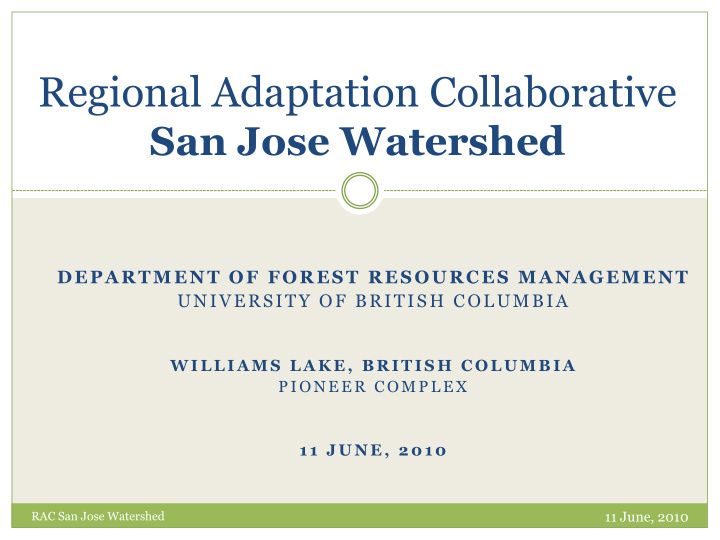



Regional Adaptation Collaborative San Jose Watershed DEPARTMENT OF FOREST RESOURCES MANAGEMENT UNIVERSITY OF BRITISH COLUMBIA W I L L I A M S L A K E , B R I T I S H C O L U M B I A P I O N E E R C O M P L E X 1 1 J U N E , 2 0 1 0 11 June, 2010 RAC San Jose Watershed
Overview Introduction Project team Progress to date Goals for today’s workshop Revised list of questions around key values Next steps 11 June, 2010 RAC San Jose Watershed
Project team Harry Nelson UBC, Forest Resources Management Ken Day UBC, Alex Fraser Research Forest Stewart Cohen UBC, Environment Canada Anne-Hélène Mathey UBC, Forest Resources Management Craig Nitschke UBC/University of Melbourne Dan Moore UBC, FRM/Geography Georg Jost UBC, FRM/Geography Adam Wei UBC Okanagan Clement Agboma UBC Okanagan Cathy Koot UBC, Alex Fraser Research Forest Phil Grace Graduate Student, UBC 11 June, 2010 RAC San Jose Watershed
The San Jose Watershed 11 June, 2010 RAC San Jose Watershed
The San Jose Watershed Water supply is a key concern City of Williams Lake aquifer Challenges identified in previous studies ( Case and Holmes ) Flow levels (low summer, high winter) Water temperature variations Fish species concerns Mountain Pine Beetle impact Biological interventions Management interventions Lack of disturbances 11 June, 2010 RAC San Jose Watershed
Project Goals Concern as to how climate change might impact flow of services and values we expect from local forest resources Through a collaborative process quantitatively assess these impacts and the effect of different forest management activities on the watershed Use this to enable planning within a long-term sustainability strategy End up with an idea of how future forest management strategies could address water concerns 11 June, 2010 RAC San Jose Watershed
Modelling Framework START : Initial Landscape (Forest Inventory) Climate Scenarios DYNA-PLAN Landscape dynamics 1. Disturbances Policy Scenarios MPB TACA Stand dynamics • Water Management Regeneration Management & Harvesting • Adaptation Growth and Yield • Sustainability 2. Forest Growth Mortality Ending Landscape (Forest Inventory) Hydrology models YAM 1. Surface water model MIKE 2. Groundwater model Satisfying outcomes? SHE Human processes Natural Processes END 11 June, 2010 RAC San Jose Watershed
Expected Outcomes Not come up with a plan, but an outline of a plan Hand off to those with the responsibility to implement Not a prescriptive output, but one that is relevant to decision making Consistent with overall RAC objectives 11 June, 2010 RAC San Jose Watershed
Progress to date April workshop Presented models to local practitioners Identified key questions and values Identified sources of data that may be of use Post-workshop team meeting Acquired data from various sources Carefully looked at each proposed question and assessed how and whether it can be modelled 11 June, 2010 RAC San Jose Watershed
11 June, 2010 RAC San Jose Watershed
Revised Questions (forest cover) Value 1: Range, ranching, grasslands 1. How much open range would there be under climate change? 2. Where are trees going to die as a result of climate change? 3. What will be the species suitability in the future across ecosystems? Value 2: Water 1. Would there be a management strategy that improves water flow? 2. Can manipulating forest cover impact peak flow? 3. What stand structure (crown closure, shading etc.) is more beneficial to water supply and resilience? 11 June, 2010 RAC San Jose Watershed
Revised Questions (forest cover) Value 3: Habitat 1. Are habitat prescriptions (e.g. mule deer winter habitat) still appropriate in the future? Value 4: Timber 1. How would salvage impact water flow? 2. Will the type of forest that grows be commercially viable? 3. How might natural disturbance change + change the landscape (fire, insect)? 11 June, 2010 RAC San Jose Watershed
Revised Questions (hydrology) Value 1: Range, ranching, grasslands 1. Is there are target proportion of open ground to closed forests? 2. How might the amount of grassland change in the future? 3. Where do we expect grassland to develop? 4. What are the effects of reopening range lands? 11 June, 2010 RAC San Jose Watershed
Revised Questions (hydrology) Value 2: Water 1. How can we manipulate forest cover to modulate peak flow? 2. How can we incorporate the current condition into the framework? 3. Under different forest types and layouts, how much precipitation actually reaches the ground? How much permeates? Runs off? Evaporates? 4. Soil water storage 5. What stand structures have the best water retention characteristics? 6. What can we expect with regards to water levels? 11 June, 2010 RAC San Jose Watershed
Revised Questions (hydrology) Value 3: Habitat 1. How will aspen fare under climate change? Value 4: Timber How sensitive are the species that are most important for forestry 1. in the region to climate change? 2. How will different cut block layouts impact water retention and flow? 3. How will species suitability change across the map? 4. What are the most sensitive stand types in the future? 5. What happens if we don’t manage stands that way? 11 June, 2010 RAC San Jose Watershed
http://sanjosewatershed.com 11 June, 2010 RAC San Jose Watershed
Recommend
More recommend